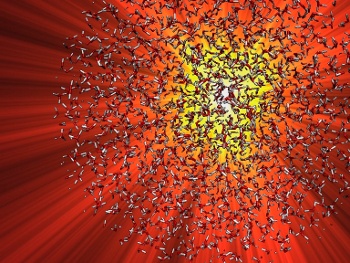Ultrafast Heating
February 14, 2014
As
Lady Macbeth so famously
said in scene VII of
MacBeth by
William Shakespeare, "If it were done when 'tis done, then 'twere well It were done quickly."[1] The idea that speed is beneficial to some processes is at the core of such important matters as
pizza delivery and
adhesive bandage removal.

"Macbeth and Banquo encountering the witches," from Holinshed's Chronicles (1587), a source book used by Shakespeare in writing MacBeth.
(Via Wikimedia Commons.)
In
materials science,
rapid thermal processing, also called rapid thermal annealing, is a method of quickly
heating an object to cause changes to its surface properties. It's effected by either passing the object, such as a
semiconductor wafer, quickly through a heated zone; or, by application of an intense burst of
radiation from
high intensity lamps or
lasers.
Rapid thermal annealing is commonly used to thermally
diffuse material from a thin surface overlayer into
wafers and other objects, to repair
ion implantation damage, and for
densification of
deposited surface features, such as
electrical conductors. It's used also for making
ohmic contact to semiconductor wafers.
Application of considerable
energy in a short interval is required for such processing, so lasers have proven ideal for rapid thermal processing. Even lasers have their limitations, since you can pack only so much
power into the very short pulses from
femtosecond lasers. Unless you're working with
chirped-pulse amplifiers, or the building-sized lasers of the
National Ignition Facility, you need to limit the size of your heated object if you want to generate large
temperature changes in a short time.
A team of
German physicists from
Hamburg, Germany, at the
Center for Free-Electron Laser Science at the
Deutsches Elektronen-Synchrotron (DESY), and the
University of Hamburg, have done
simulations on how
water will react to ultrafast heating.[2-3] As you realize by looking through a thick layer of water to the bottom of your
cup, water doesn't
absorb electromagnetic radiation at all
wavelengths. The German team looked at
terahertz radiation which is readily absorbed by water.

Deutsches Elektronen-Synchrotron (DESY) logo on its entrance sign.
(From a photograph by Uvainio, via Wikimedia Commons.)
The computer simulations were performed at the
Forschungszentrum Jülich, and the computations required 200,000 hours of
processor time on a
massively parallel computer.[DESY] The goal of the simulations was the heating of a small volume of water (a
nanoliter) by 600 degrees
Celsius in half a
picosecond.[3] An intense terahertz pulse can accomplish this.[2] The short time is critical, since the
rotational correlation time of water, the time it takes for a molecule to rotate a
radian (about 57.3 degrees), is 1.7 picoseconds.[4]
Although these are just simulations, it would be possible to do such an ultrafast heating on a nanoliter volume through use of a
free-electron laser.[3] Under such an excitation, the water molecules would remain in place for almost a millisecond, although the
molecular vibration is equivalent to 600°C. The ensemble of molecules would be a structureless, gas-like system at the
density of
liquid water, but with the
hydrogen-bonding removed.[2-3]

Artist's rendering of water molecules heated by a terahertz flash to 600 degrees centigrade.
The excited water molecules are in essentially the same place as they were in the liquid.
(Deutsches Elektronen-Synchrotron image by Oriol Vendrell.)
Since water is a
solvent for so many
chemical reactions, the capability for such an ultrafast heating leads to quite a few
research possibilities. Says DESY scientist,
Oriol Vendrell,
"Water is not just a passive solvent, but plays an important role in the dynamics of biological and chemical processes by stabilizing certain chemical compounds and enabling specific reactions."[3]
The trick, of course, is being able to extract
data from your
experiment in such a short time frame. This would be possible using ultrashort
X-ray flashes from a 3.4-
kilometer-long X-ray free-electron laser (XFEL) being built at DESY campus. This XFEL, synchronized with the terahertz burst, would generate 27,000 intense X-ray laser flashes per second, so it can record the chemical reactions as they happen.[3]
As for the
adage that "
a watched pot never boils," an
eye blink is about 350 milliseconds. You can boil a lot of water with ultrashort terahertz radiation in that time.
References:
- The Tragedy of Macbeth by William Shakespeare, free versions at Project Gutenberg.
- Pankaj Kr. Mishra, Oriol Vendrell and Robin Santra, "Ultrafast Energy Transfer to Liquid Water by Sub-Picosecond High- Intensity Terahertz Pulses: An Ab Initio Molecular Dynamics Study," Angewandte Chemie - International Edition, vol. 52, no. 51 (December 16, 2013), pp. 13685-13687.
- Ultrafast heating of water - This pot boils faster than you can watch it, Deutsches Elektronen-Synchrotron/Helmholtz Association Press Release, December 16, 2013.
- D. Lankhorst, J. Schriever and J. C. Leyte, "Determination of the Rotational Correlation Time of Water by Proton NMR Relaxation in H217O and Some Related Results," Berichte der Bunsengesellschaft für physikalische Chemie, vol. 86, no. 3 (March, 1982), pp. 215-221.
Permanent Link to this article
Linked Keywords: Lady Macbeth; MacBeth; William Shakespeare; pizza delivery; adhesive bandage; Holinshed's Chronicles (1587); Wikimedia Commons; materials science; rapid thermal processing; heat; semiconductor wafer; radiation; high-intensity discharge lamp; high intensity lamp; laser; diffusion; diffuse; wafer; ion implantation; sintering; densification; thin film; electrical conductor; ohmic contact; energy; power; mode-locking; femtosecond laser; chirped-pulse amplifier; National Ignition Facility; temperature; Germany; German; physicist; Hamburg, Germany; Center for Free-Electron Laser Science; Deutsches Elektronen-Synchrotron; DESY; University of Hamburg; computer simulation; water">water; cup; absorption of electromagnetic radiation; electromagnetic radiation; wavelength; terahertz radiation; logo; Forschungszentrum Jülich; central processing unit; parallel computing; massively parallel computer; nanoliter; Celsius; picosecond; rotational correlation time; radian; free-electron laser; molecular vibration; density; liquid; hydrogen bond; hydrogen-bonding; solvent; chemical reaction; research; Oriol Vendrell; data; experiment; X-ray; kilometer; adage; a watched pot never boils; eye blink.